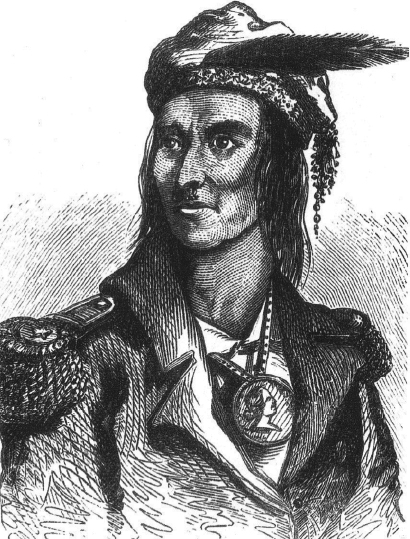Tecumseh and Tippecanoe
Printed Page 274

While the Madisons cemented alliances at home, difficulties with Britain and France overseas and with Indians in the old Northwest continued to increase. The Shawnee chief Tecumseh was, by all accounts, a charismatic leader. The Ohio Country, where Tecumseh was born in 1768, was home to some dozen Indian tribes. During the Revolutionary War, the region became a battleground, and Tecumseh lost his father and two brothers to American fighters. The Revolution’s end in 1783 brought no peace to Indian country. The youthful Tecumseh fought at the battle of Fallen Timbers (see "Ohio Indians in the Northwest" in chapter 9), a major Indian defeat, and stood by as eight treaties ceded much of Ohio to the Americans between 1795 and 1805. Some resigned Indians looked for ways to accommodate, taking up farming, trade, and intermarriage with white settlers. Others spent their treaty payments on alcohol. Tecumseh’s younger brother Tenskwatawa led an embittered life of idleness and drink. But Tecumseh rejected accommodation and instead campaigned for a return to ancient ways. Donning traditional animal-skin clothing, he traveled around the Great Lakes region persuading tribes to join his pan-Indian confederacy. The territorial governor of Indiana, William Henry Harrison, both admired and feared Tecumseh, calling him “one of those uncommon geniuses which spring up occasionally to produce revolutions.”
Even Tecumseh’s dissolute brother was born anew. After a near-death experience in 1805, Tenskwatawa revived and recounted a startling vision of meeting the Master of Life. Renaming himself the Prophet, he urged his many Indian followers to regard whites as children of the Evil Spirit, destined to be destroyed.
In the years after 1805, Tecumseh actively solidified his confederacy, while the more northern tribes renewed their ties with supportive British agents in Canada, a potential source of food and weapons. If the United States went to war with Britain, there would clearly be serious repercussions on the frontier.
Shifting demographics put the Indians under pressure. The 1810 census counted some 230,000 Americans in Ohio, while another 40,000 inhabited the territories of Indiana, Illinois, and Michigan. The Indian population of the same area was much smaller, probably about 70,000.

Up to 1805, Indiana’s territorial governor, William Henry Harrison, had negotiated a series of treaties in a divide-and-conquer strategy aimed at extracting Indian lands for paltry payments. But with the rise to power of Tecumseh and his brother Tenskwatawa, the Prophet, Harrison’s strategy faltered. A fundamental part of Tecumseh’s message was the assertion that all Indian lands were held in common by all the tribes. “No tribe has the right to sell [these lands], even to each other, much less to strangers … ,” Tecumseh said. “Sell a country! Why not sell the air, the great sea, as well as the earth? Didn’t the Great Spirit make them all for the use of his children?” In 1809, while Tecumseh was away on a recruiting trip, Harrison assembled the leaders of the Potawatomi, Miami, and Delaware tribes to negotiate the Treaty of Fort Wayne. After promising (falsely) that this was the last cession of land the United States would seek, Harrison secured three million acres at about two cents per acre.
CHAPTER LOCATOR
How did Jefferson attempt to undo the Federalist innovations of earlier administrations?
What was the significance of the Louisiana Purchase for the United States?
Why did Congress declare war on Great Britain in 1812?
How did the civil status of American women and men differ in the early Republic?
Why did partisan conflict increase during the administrations of Monroe and Adams?
Conclusion: How did republican simplicity become complex?
 LearningCurve
LearningCurve
Check what you know.
When he returned, Tecumseh was furious with both Harrison and the tribal leaders. Leaving his brother in charge at Prophetstown on the Tippecanoe River, the Shawnee chief left to seek alliances with tribes in the South. In November 1811, Harrison decided to attack Prophetstown with a thousand men. The two-hour battle resulted in the deaths of sixty-two Americans and forty Indians before the Prophet’s forces fled. The Americans won the battle of Tippecanoe, but Tecumseh was now more ready than ever to make war on the United States.
 An attack on Shawnee Indians at Prophetstown on the Tippecanoe River in 1811 by American forces headed by William Henry Harrison, Indiana’s territorial governor. Tenskwatawa, the Prophet, fled with his followers. Tecumseh, his brother, deepened his resolve to make war on the United States.
An attack on Shawnee Indians at Prophetstown on the Tippecanoe River in 1811 by American forces headed by William Henry Harrison, Indiana’s territorial governor. Tenskwatawa, the Prophet, fled with his followers. Tecumseh, his brother, deepened his resolve to make war on the United States.